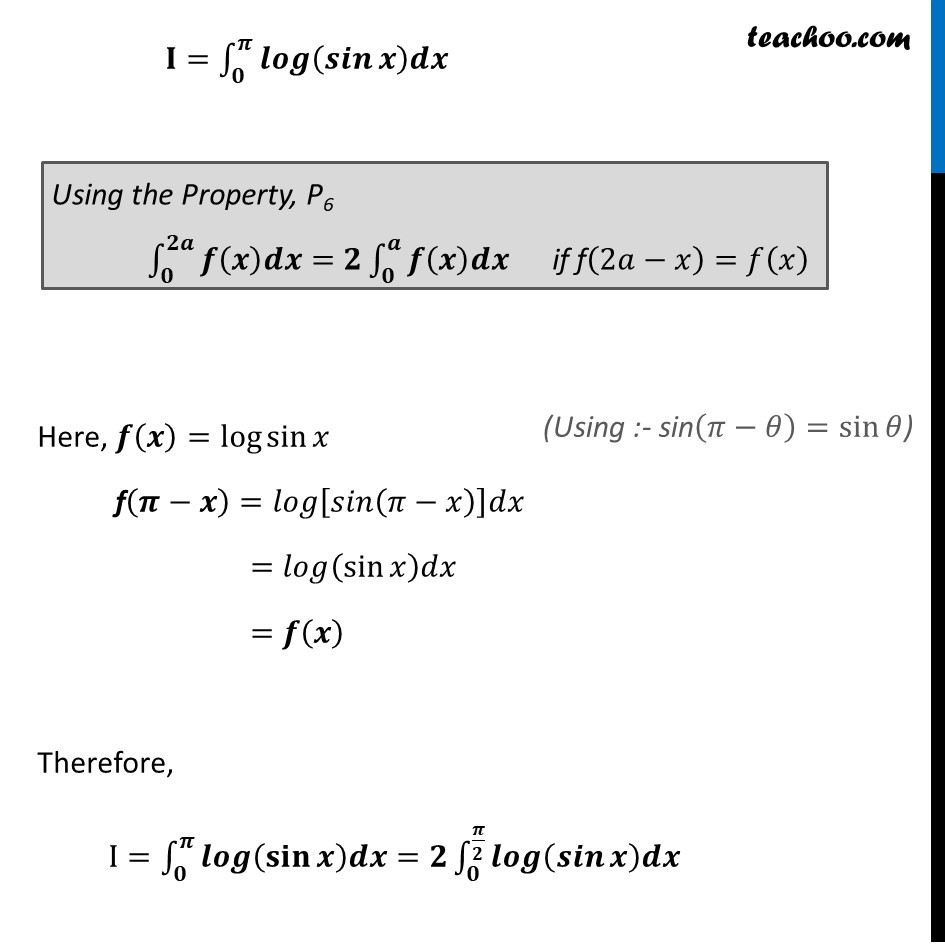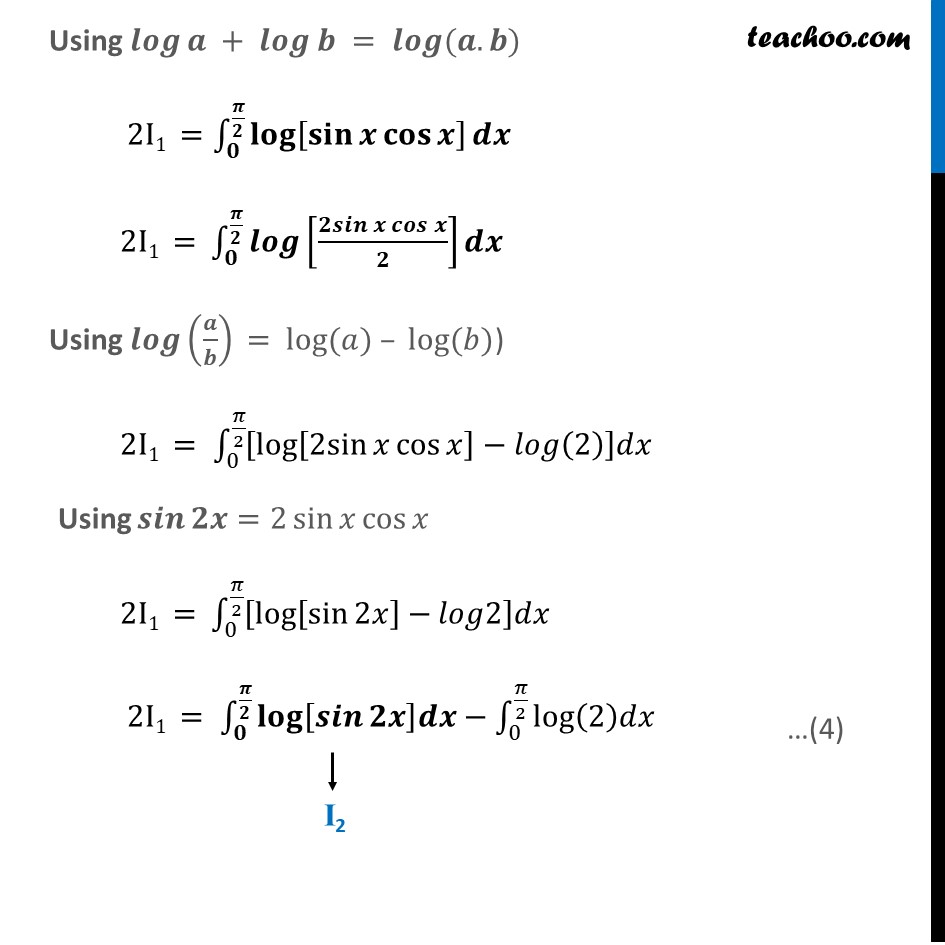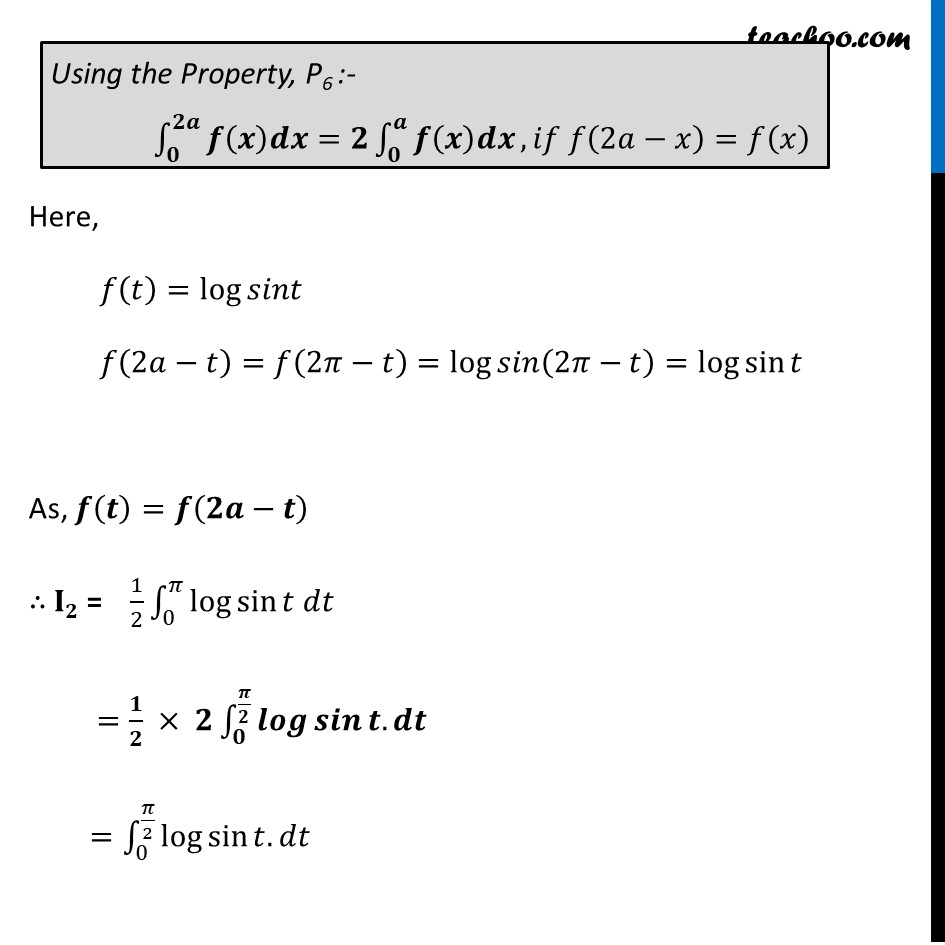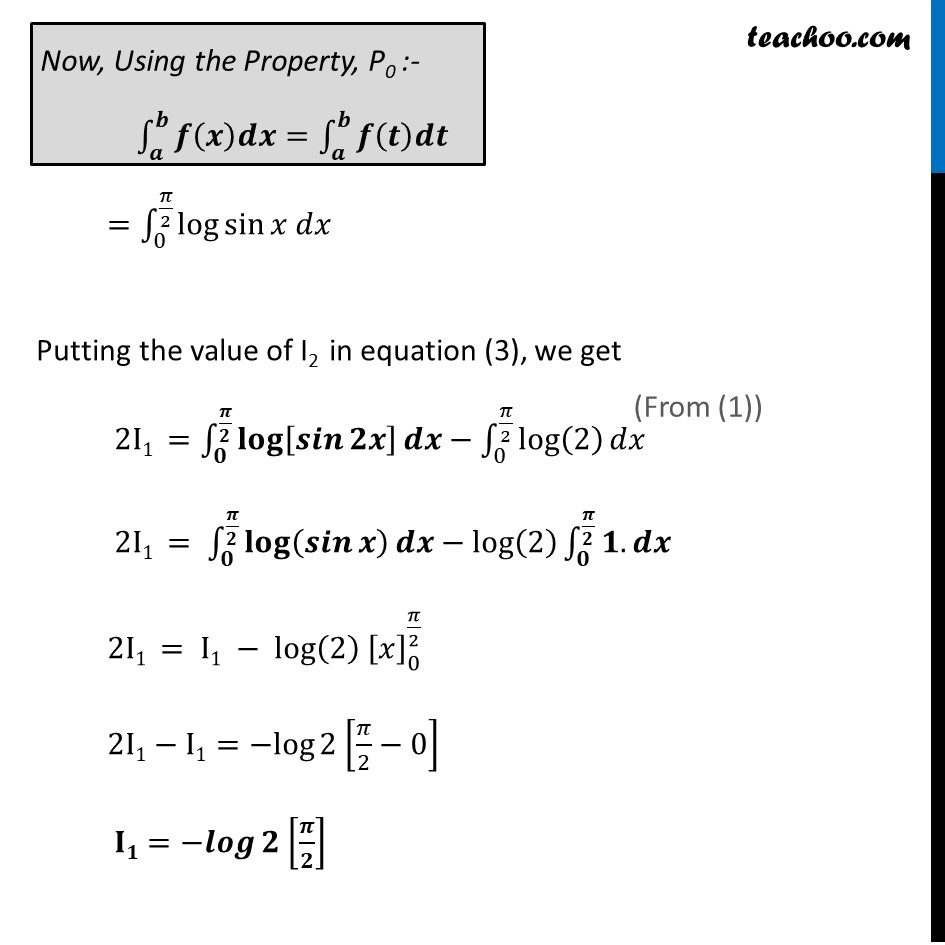








Definite Integration by properties - P4
Definite Integration by properties - P4
Last updated at Dec. 16, 2024 by Teachoo









Transcript
Ex 7.10, 16 By using the properties of definite integrals, evaluate the integrals : ∫_0^𝜋▒log(1+cos𝑥 ) 𝑑𝑥 Let I=∫_𝟎^𝝅▒𝒍𝒐𝒈(𝟏+𝒄𝒐𝒔𝒙 ) 𝒅𝒙 ∴ I=∫_0^𝜋▒log(1+𝑐𝑜𝑠(𝜋−𝑥)) 𝑑𝑥 𝐈=∫_𝟎^𝝅▒𝐥𝐨𝐠(𝟏−𝒄𝒐𝒔𝒙 ) 𝑑𝑥 Adding (1) and (2) i.e. (1) + (2) I+I=∫_0^𝜋▒𝑙𝑜𝑔(1+cos𝑥 )𝑑𝑥+∫_0^𝜋▒𝑙𝑜𝑔(1−cos𝑥 )𝑑𝑥 𝟐𝐈=∫_𝟎^𝝅▒[𝒍𝒐𝒈(𝟏+𝒄𝒐𝒔𝒙 )+𝒍𝒐𝒈(𝟏−𝒄𝒐𝒔𝒙 )]𝒅𝒙 "Using log(a) + log(b)" = "log(a.b)") 2I=∫_0^𝜋▒𝒍𝒐𝒈[(𝟏+𝒄𝒐𝒔𝒙 )(𝟏−𝒄𝒐𝒔𝒙 )]𝒅𝒙 2I=∫_0^𝜋▒𝑙𝑜𝑔[1−cos^2𝑥 ]𝑑𝑥 2I=∫_0^𝜋▒𝑙𝑜𝑔(〖𝑠𝑖𝑛〗^2𝑥 )𝑑𝑥 Using log 𝒂^𝒃=𝒃 𝒍𝒐𝒈𝒂 2I=∫_0^𝜋▒〖2 𝑙𝑜𝑔(𝑠𝑖𝑛𝑥 )𝑑𝑥〗 2I=2∫_0^𝜋▒𝑙𝑜𝑔(𝑠𝑖𝑛𝑥 )𝑑𝑥 𝐈=∫_𝟎^𝝅▒𝒍𝒐𝒈(𝒔𝒊𝒏𝒙 )𝒅𝒙 Here, 𝒇(𝒙)=logsin𝑥 f(𝝅−𝒙)=𝑙𝑜𝑔[𝑠𝑖𝑛(𝜋−𝑥)]𝑑𝑥 =𝑙𝑜𝑔(sin𝑥 )𝑑𝑥 =𝒇(𝒙) Therefore, I=∫_𝟎^𝝅▒𝒍𝒐𝒈(𝐬𝐢𝐧𝒙 )𝒅𝒙=𝟐∫_𝟎^(𝝅/𝟐)▒𝒍𝒐𝒈(𝒔𝒊𝒏𝒙 )𝒅𝒙 Let I1=∫_0^(𝜋/2 )▒𝑙𝑜𝑔(𝑠𝑖𝑛𝑥) 𝑑𝑥 Solving 𝐈𝟏 I1=∫_0^(𝜋/2 )▒𝑙𝑜𝑔(𝑠𝑖𝑛𝑥) 𝑑𝑥 ∴ I1=∫_𝟎^(𝝅/𝟐)▒𝒔𝒊𝒏(𝝅/𝟐−𝒙)𝒅𝒙 I1= ∫_𝟎^(𝝅/𝟐)▒𝒍𝒐𝒈(𝒄𝒐𝒔𝒙 )𝒅𝒙 Adding (2) and (3) i.e. (2) + (3) 𝐈𝟏 + 𝐈𝟏 =∫_𝟎^(𝝅/𝟐)▒〖𝒍𝒐𝒈(𝒔𝒊𝒏𝒙 )𝒅𝒙+∫_𝟎^(𝝅/𝟐)▒𝒍𝒐𝒈(𝐜𝐨𝐬𝒙 )𝒅𝒙〗 "Using" 𝒍𝒐𝒈𝒂 + 𝒍𝒐𝒈𝒃 = 𝒍𝒐𝒈(𝒂.𝒃) 2I1 =∫_𝟎^(𝝅/𝟐)▒〖𝐥𝐨𝐠[𝐬𝐢𝐧〖𝒙 𝐜𝐨𝐬𝒙 〗 ] 𝒅𝒙〗 2I1 = ∫_𝟎^(𝝅/𝟐)▒〖𝒍𝒐𝒈[𝟐𝒔𝒊𝒏〖𝒙 𝒄𝒐𝒔𝒙 〗/𝟐] 𝒅𝒙〗 "Using " 𝒍𝒐𝒈(𝒂/𝒃) = log(𝑎) – log(𝑏)) 2I1 = ∫_0^(𝜋/2)▒[log[2sin〖𝑥 cos𝑥 〗 ]−𝑙𝑜𝑔(2)]𝑑𝑥 "Using" 𝒔𝒊𝒏𝟐𝒙=2 sin〖𝑥 cos𝑥 〗 2I1 = ∫_0^(𝜋/2)▒[log[sin2𝑥 ]−𝑙𝑜𝑔2]𝑑𝑥 2I1 = ∫_𝟎^(𝝅/𝟐)▒𝐥𝐨𝐠[𝒔𝒊𝒏𝟐𝒙 ]𝒅𝒙−∫_0^(𝜋/2)▒log(2)𝑑𝑥 Solving 𝐈𝟐 𝐈𝟐=∫_𝟎^(𝝅/𝟐)▒〖𝐥𝐨𝐠 𝒔𝒊𝒏𝟐𝒙 𝒅𝒙〗 Let 2𝑥=𝑡 Differentiating both sides w.r.t.𝑥 2=𝑑𝑡/𝑑𝑥 𝑑𝑥=𝑑𝑡/2 ∴ Putting the values of t and 𝑑𝑡 and changing the limits, I2 =∫_0^(𝜋/2)▒log(sin2𝑥 )𝑑𝑥 I2 = ∫_0^𝜋▒〖log(sin𝑡 ) 𝑑𝑡/2〗 𝐈𝟐 = 𝟏/𝟐 ∫_𝟎^𝝅▒𝐥𝐨𝐠(𝒔𝒊𝒏𝒕 )𝒅𝒕 Here, 𝑓(𝑡)=log𝑠𝑖𝑛𝑡 𝑓(2𝑎−𝑡)=𝑓(2𝜋−𝑡)=log𝑠𝑖𝑛(2𝜋−𝑡)=logsin𝑡 As, 𝒇(𝒕)=𝒇(𝟐𝒂−𝒕) ∴ 𝐈𝟐 = 1/2 ∫_0^𝜋▒logsin〖𝑡 𝑑𝑡〗 =𝟏/𝟐 × 𝟐∫_𝟎^(𝝅/𝟐)▒𝒍𝒐𝒈𝒔𝒊𝒏〖𝒕. 𝒅𝒕〗 =∫_0^(𝜋/2)▒logsin〖𝑡. 𝑑𝑡〗 =∫_0^(𝜋/2)▒logsin〖𝑥 𝑑𝑥〗 Putting the value of I2 in equation (3), we get 2I1 =∫_𝟎^(𝝅/𝟐)▒𝐥𝐨𝐠[𝒔𝒊𝒏𝟐𝒙 ]𝒅𝒙 −∫_0^(𝜋/2)▒log(2)𝑑𝑥 2I1 = ∫_𝟎^(𝝅/𝟐)▒𝐥𝐨𝐠(𝒔𝒊𝒏𝒙 )𝒅𝒙 −log(2) ∫_𝟎^(𝝅/𝟐)▒〖𝟏.〗𝒅𝒙 2I1 = I1 − log(2) [𝑥]_0^(𝜋/2) 2I1−I1=−log2 [𝜋/2−0] 𝐈𝟏=−𝒍𝒐𝒈𝟐 [𝝅/𝟐] Hence, 𝐈=2 I1= 2 × (−𝜋)/2 log2 =−𝝅 𝒍𝒐𝒈𝟐